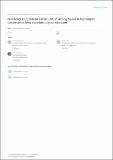| dc.description.abstract | Background: It was reported by clinicians working in the Ngorongoro
Conservation Area that about 40% of Maasai pregnant women
reporting at the Antenatal Clinic were diagnosed with oral thrush.
However, it was not immediately determined what factors predispose
these women to oral thrush. This study aimed at finding out the
prevalence of oral thrush in the Maasai women community and the
identification of predisposing factors.
Methods: This was a cross sectional study done in the Ngorongoro
Conservation Area among Maasai women of reproductive age
(15–49 years). Convenience sampling technique was used to select
participants from all participating villages. Participants were clinically
examined for oral thrush lesions and a structured interview guide
was used to collect information on age, parity, pregnancy status and
history of breastfeeding. To explore the possible predisposing factors
for oral thrush, anthropometric measurements including weight and
height were taken and also blood samples were collected from participants
and tested for HIV, syphilis and blood sugar. Multivariate logistic
regression was used to obtain independent predictors of oral thrush.
Results: The prevalence of oral thrush among study participants was
32%. Oral thrush prevalence was significantly higher in non-pregnant
than pregnant women (p=0.000). Amongst the non-pregnant
women, oral thrush was significantly higher in breastfeeding than the
non-breast feeding participants. Univariate logistic regression showed
that non-pregnant women had higher odds of getting oral thrush
compared to pregnant women [OR 21.8; (95% CI 9.6, 49.6)]. Amongst
the non-pregnant women, breastfeeding women had increased odds
or higher chances of getting oral thrush compared to the non-breastfeeding
women [OR 15.8; (95% CI: 7.2, 34.8)]. In the multivariate
analysis, breastfeeding women adjusted odds ratio (AOR) 2.88; (95%
CI: 0.99, 8.3) and non-pregnant women AOR 0.09; (95% CI: 0.03,
0.27). Two factors that predicted oral thrush are breastfeeding and
not being pregnant.
Conclusions: From the results, breastfeeding non pregnant women
were at a higher risk of developing oral thrush. Possible predisposing
factors are discussed. | en_US |

